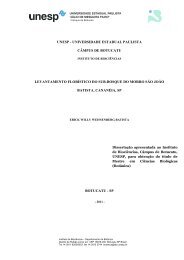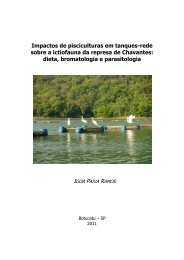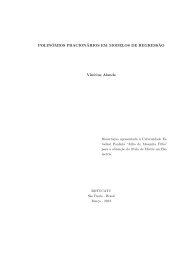Visualizar Tese - Instituto de Biociências - Unesp
Visualizar Tese - Instituto de Biociências - Unesp
Visualizar Tese - Instituto de Biociências - Unesp
Create successful ePaper yourself
Turn your PDF publications into a flip-book with our unique Google optimized e-Paper software.
Andreo Fernando AguiarMETHODSResearch <strong>de</strong>sign. An animal mo<strong>de</strong>l was used to test the hypothesis thathypertrophic and phenotypic response of skeletal muscle induced by long-term RTcould be associated with an increase in MyoD, myogenin and IGF-I gene expression. Tothis purpose, the animals were submitted to a progressive RT program during 8 or 12weeks using a weight lifted mo<strong>de</strong>l well established, that transcribes the traditionalhuman squat exercise (57). To ensure the same training intensity throughout theexperiment period, overload adjustments were ma<strong>de</strong> biweekly, through the test of onerepetitionmaximum (1RM). The relative intensity (65-75% of 1RM) and volume (foursets of 10-12 repetition) of training were the same in the in all trained rats, ensuring thesame stimulus intensity to the recruited muscles. We ensured that this protocol provi<strong>de</strong>dan effective manner to investigate the effects of RT on the muscle morphological andmolecular parameters. At the end of the experiment, the plantaris muscle of right andleft legs was removed and its weight was normalized to body weight (muscleweight/body weight ratio). The middle portion of right muscle was collected formorphometrical, histochemical and biochemical analysis. The left muscle was collectedfor molecular analysis. Samples were kept at -80ºC until use. The animal mo<strong>de</strong>lprovi<strong>de</strong>d the unique and accurate way to isolate single muscles and perform analysis onwhole muscle preparations, reflecting the total muscle response. In addition, our animalmo<strong>de</strong>l ensures total control over the variables (e.g., food intake, lifestyle, motivation,and technique of movement) that can affect the phenomenon investigated, allowing areliable response when these same relationships are tested in human subjects. Weinvestigated the plantaris muscle because it is highly recruited in our mo<strong>de</strong>l of RT and itpossesses a mixed fast-twitch fibers-based phenotype, indicating a significant capabilityto support the increased overload during the long-term RT.Animals and experimental groups. Thirty-two male Wistar rats (80 days old,250-300 g) were obtained from the Multidisciplinary Center for Biological Investigation(CEMIB, UNICAMP, Campinas, São Paulo, Brazil). They were housed in collectivepolypropylene cages (4 animals per cage) covered with metallic grids, in a temperaturecontrolledroom (22-24ºC) un<strong>de</strong>r a 12-hour light–dark cycle, and provi<strong>de</strong>d withunlimited access to standard rat chow and water. We used the in<strong>de</strong>pen<strong>de</strong>nt variable(training) to examine its effects on muscle parameters (<strong>de</strong>pen<strong>de</strong>nt variables). For thispurpose, rats were randomly divi<strong>de</strong>d into four groups: 8 weeks control (C8, n = 8), 8-46
















